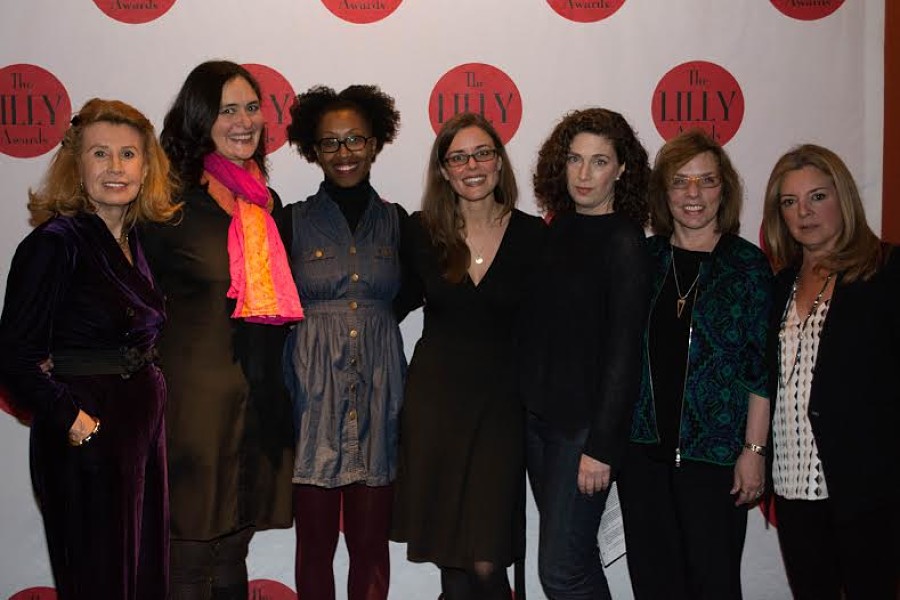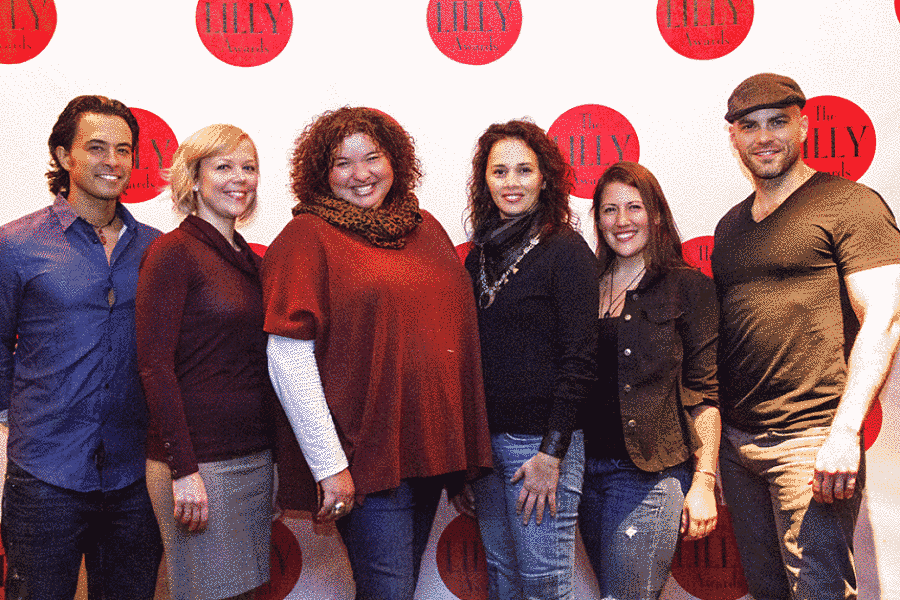NEW YORK CITY: It’s apropos that Laura Schellhardt’s play The Comparables opens with the Madeleine Albright quote, “There’s a special place in hell for women who don’t help other women.” Schellhardt’s play kicked off a recent reading series of plays selected from the 2014 Kilroys List, presented by the Lilly Awards Foundation. Both groups advocate for women, particularly around issues of gender disparity in the theatre, and these recent readings—held over three consecutive Mondays, March 9, 16 and 23—were their highest-profile joint venture so far.
The Kilroys were born last year with the release of a list of 46 unproduced or under-produced plays by female-identified playwrights, as a step toward addressing the “systemic underrepresentation of female voices in the American theatre.” The 46 on the list were selected from more than 300 new plays, identified and nominated by industry leaders for consideration, and many have seen production since their appearance on the list.
Lilly Awards Foundation president Marsha Norman told the crowd gathered for the first reading that the Kilroys List was “the perfect answer” to the lack of gender parity in the theatre. And both plan to do it again next year, she said: There will a 2015 Kilroys List, and another Lillys reading series next year.

Although the Lillys presented the readings, they left selection of the plays to the directors, all of them former Lilly Award winners: Leigh Silverman, Lear deBessonet, and Liesl Tommy. From the world of high-stakes real estate to a discussion between the KKK and Native Americans to the rural Midwestern girls’ basketball teams of 1930s, the three plays selected—The Comparables, What Would Crazy Horse Do? and The Tall Girls—look at a broad range of female characters and circumstances, and challenge audiences to see a vast spectrum of experiences not often seen onstage.
“The Kilroys and the Lillys are both like lighthouses, shedding light on inequity that simply must be addressed,” says director deBessonet in an interview. She chose to direct The Comparables in part because “the play is looking at some of the same questions about gender parity that the Lillys and Kilroys are, albeit through a very different lens.”
In making the list, the Kilroys set out to spotlight plays and playwrights overlooked less because of overt discrimination than more insidious forms of prejudice. As Meg Miroshnik, both a Kilroy and the playwright of The Tall Girls, explains, “The Kilroys talk a lot about unconscious bias and its role in the careers of women and trans* writers and artists of color. Most people in theatre, in my experience, absolutely want to address the issue of diversity on and behind American stages. There are not shadowy cabals sitting down to program seasons consisting entirely of plays written and directed by white men.”
So how does that still happen? Joy Meads, another Kilroy, cites various ways gender bias can subtly rear up, including not only in which plays make it to the stage but “how those plays are received (I definitely see gender bias in reviews), which well-received plays are picked up for second, third and fourth productions so they have the potential to become widely known, and then which plays are revived.”
Meads says that the list was intended to chip away at the excuse that the underrepresentation of plays by women was either because “there aren’t enough plays or the plays aren’t good enough. I just never wanted to hear another artistic director say, ‘We just choose the best plays.’ Because I know how many excellent plays are overlooked. The idea that the disparity we see year after year is due to pure meritocracy is just false, and we need to move beyond those false answers. I don’t think it’s an intentional falsehood. But not enough producers understand the ways that their concept of ‘quality’ can be inflected by the history and legacy of bias that we’ve all come up in—the ways that unconscious bias can shape our assumptions and expectations about what voices and stories matter.”
Larissa FastHorse, who wrote What Would Crazy Horse Do?, believes that the list is succeeding at negating those excuses. “No one can say they don’t know where to find women writers: There’s a list with over 300 professionally recommended scripts available to everyone,” says FastHorse. “If you can’t find us, you aren’t trying.”

The Kilroys are not letting up either. They’re learning from the experiences of the 2014 list (which had its vocal critics) and are working to improve their efforts in 2015 by expanding the pool of nominators.
“We tried to expand the ethnic diversity of the nominators on the list,” explains Meads. “We tried to expand the geographic diversity of the nominators on the list, and also the aesthetic diversity,” explains Meads. Adds fellow Kilroy Sheila Callaghan, “We have other initiatives that will be revolving around the list. The list is just the primary initiative.”
The Kilroys have also surveyed the playwrights on the list to understand the efficacy of the initiative and the experiences of the playwrights since their inclusion. They have just started to analyze the responses, and Callaghan says that signs are positive: Playwrights report more productions and more requests for scripts. But she was quick to point out that statistics don’t tell the whole story. “Once those numbers go up, you kind of feel absolved of any responsibility to continue to act,” Callaghan says. “But that doesn’t address the unconscious bias or the problem in the first place.”
FastHorse is among those who saw concrete benefits from being included on the list.
“Professionally the list got my work read by more people in the past year than in the three previous years combined,” she says. It has also reframed the position she often finds herself in. “It was a huge personal validation because it wasn’t a list of Native American or people-of-color playwrights, which is where most people pigeonhole me first. There were so many women I love and admire on the list. I was so honored.”
Schellhardt has also had a positive experience: Her play The Comparables is in the midst of its world premiere at Seattle Repertory Theatre. And while Miroshnik’s Tall Girls had its premiere last year at Atlanta’s Alliance Theatre, the Lillys reading in New York has provided opportunities she wouldn’t otherwise have had.
“I’ve been lucky enough to work a bunch regionally, but not so much in New York,” says Miroshnik. “So this opportunity—to get to work with the incredible Lillys and with Leigh Silverman, whose work I’ve admired from afar for years—is very much appreciated.”
Beyond the Lillys readings, there were “AfterChats” hosted by another group of female theatre advocates from the website the Interval. And in Los Angeles, the BGB Staged Readings series is taking up the idea, with free monthly readings of plays from the list (the first, earlier this month, was Tanya Barfield’s The Call, directed by Khanisha Foster). And the Kilroys say they’re aware of several theatre companies who are systematically reviewing the 46 plays on the list.
The Kilroys see movement well beyond their own work.
“The Kilroys stand alongside many, many organizations and individuals who are committed to seeing the population of this country more accurately represented on its stages,” says Miroshnik. As Meads explains, “We see this as one action building upon a lot of activism that has come before and that is part of a larger constellation or tapestry of efforts.” The idea is that each group can chip away at the overall problem and “that all of us together can break this issue that has been so persistent, so stubborn for so long,” Meads suggests.
Collaboration and coordination seem to be the order of the day, as these groups look forward to new initiatives and back to the leaders who helped them get to this point. One unplanned joy of creating the Kilroys has been the kudos it’s received from esteemed women in the field. For Meads, the one whose response especially touched her was Paula Vogel.
“It’s been really lovely hearing from her—how moved she is to see this generation of female playwrights standing up for each other and supporting each other. Those are women who were inspiring to us, and it’s moving to be connected to them and to feel united in the same struggle.”


